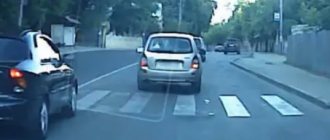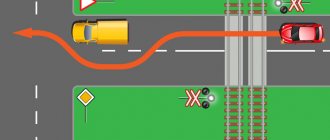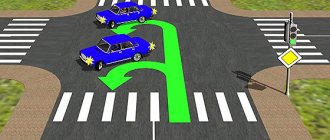Basic Concepts
The rules of the road clearly define concepts that are similar in everyday perception and do not at first glance have a significant difference.
These include:
- Overtaking is a temporary change of lane to the line of oncoming traffic with an increase in speed, in order to bypass the vehicle in front and then return to your path on a two-way highway.
- Advancement is a change in traffic lane for the purpose of overtaking, but without entering the oncoming lane.
- Changing lanes is a change in the trajectory of movement, that is, a transition from one path to another, but not accompanied by driving onto an oncoming road and not always associated with overtaking other cars.
Despite the obvious similarity of the concepts, it is worth noting that, unlike changing lanes and getting ahead, overtaking maneuvers are allowed only if certain conditions are met. Each maneuver must be accompanied by light and sound signals informing about the driver’s actions.
When driving, it is important not only to correctly interpret the content of road signs and markings, but also to classify your actions. This will allow you to avoid unpleasant sanctions and accidents due to negligence.
Where overtaking and advancing are allowed
- The time for maneuver and the distance to the vehicle ahead in the oncoming lane are correctly calculated.
- When the car is as close as possible to the vehicle in front, the turn signal turns on and advances.
- The manipulations will take a short amount of time, and the car will be returned to its lane of the road again.
- When the maneuver is completed, it is necessary to turn on the right turn signal, thereby warning other road users of your intention to return to the previous lane.
- When signs are installed in a certain area prohibiting this maneuver. This means that performing it will be extremely dangerous.
- In the case when the vehicle driving ahead turns on the light signal indicating a turn. In this case, in order to avoid a collision, you must wait until the motorist completes his maneuver, and only then change lanes.
- If the driver of a vehicle moving behind begins to overtake, you must let him pass, and only then, after making sure that the road is clear, begin the maneuver.
Types of advance
Advancement is a more general concept than overtaking, since its main types include:
- Accelerating without changing lanes, which will actually be recognized as advancing, since the adjacent vehicle that was previously in front or to the side will be behind.
- Passing a vehicle in the left lane as a result of changing lanes from the extreme or middle lane.
- Overtaking associated with entering the oncoming line.
The list of acceptable types of lane changes is based on the fact that even at high speed limits there is no danger for road users.
The distinction between the concepts of overtaking and advancing occurred in 2010; before that, they actually meant the same thing. It is important for modern car enthusiasts to know not only the difference in terminology, but also how to behave.
Traffic rules on the topic
There are many definitions in the General Provisions of the Traffic Regulations. We are interested in three definitions:
- The shoulder is an element of the road. It adjoins the roadway at the same level, differs in the type of coating or is distinguished using markings.
- Overtaking is getting one or more cars ahead of you on the road (the traffic rules say). Overtaking is when a vehicle enters the oncoming lane and then returns to the previously occupied lane. As such, pulling to the side of the road is not overtaking. It is only possible on the left side.
- Article 1, paragraph 2 of the traffic rules states that ahead is the movement of a vehicle at a speed that exceeds the speed of a passing vehicle. Why is this concept here? The thing is that in the traffic rules there is no concept of “overtaking on the right”.
IMPORTANT! The terms “overtaking” and “advancing” should be distinguished: the first is entering the lane of oncoming traffic.
It will be useful for each driver to learn about other fines for overtaking, for example, when performing this maneuver at an intersection, on a bridge, on a pedestrian crossing, across a single and double solid line, under a prohibitory sign, as well as for double overtaking.
Overtaking procedure
Overtaking is one of the most dangerous maneuvers that drivers make on the highway.
The fact is that at the moment of performing an action they become dependent on the actions of machines from both directions. Maximum concentration and concentration on the process is required so that everything goes smoothly and does not cause the need for other drivers to make emergency braking or turn. The main recommendations when overtaking include:
- turn on the turn signal to warn nearby vehicles that they are planning a maneuver;
- activate a more powerful gear so that the car can perform the manipulation;
- check whether overtaking will not interfere with other participants, for example, if the driver behind has already begun to make a maneuver, then you should let him pass;
- estimate the distance to cars driving in the oncoming lane in order to determine the temporary opportunity to complete the changeover into your lane.
You should not attempt to overtake on a hill, as visibility of oncoming traffic is limited. Also, in bad weather conditions there is a risk of not noticing other vehicles.
It is not recommended to overtake on narrow two-lane and mountain roads. In areas where it is difficult for two directions to pass each other, three cars driving at the same time will lead to a serious accident.
Leading on the right within one lane
At the same time, I encounter a situation where a car coming from behind passes me on the right, squeezing me towards the center of the road. After overtaking (overtaking?) they simply drive ahead of me. The purpose of such overtaking is unclear (well, actually it is clear, but we won’t talk about that).
I had already come to terms with such situations, if not for the incident yesterday. I drove through the railway crossing, pressing as closely as possible to the median, while being in my lane. There's a truck coming towards us. The width of the crossing is very narrow, just enough to allow a truck to pass with a small margin.
We recommend reading: Negative reference to the father of a student who did not attend school
Leading on the right
Based on the definitions of the terms, overtaking and advancing, it follows that in Russia, with established left-hand traffic, such overtaking on the right does not exist, since this does not physically involve entering the oncoming lane. Such a maneuver will be considered ahead of the curve. There are no restrictions on changing lanes for the purpose of passing on the right in the traffic rules, but this does not mean that what is not prohibited is permitted. Overtaking on the right side of the road is not allowed, as this is contrary to other rules.
The norm for advance on the right is not highlighted separately due to the fact that the action taken will be associated with other violations.
These include:
- driving to the side of the road in order to get ahead of a vehicle traveling in the right lane;
- the vehicle speed in the right lane does not exceed the middle lane speed.
If a driver moves from the left or middle lane to the right, which is moving faster, then this will be considered a lane change. Changing lanes from the left lane will also be considered ahead if cars plan to make a turn there.
As for driving onto tram rails, this is prohibited, especially if it is associated with an attempt to overtake.
The traffic rules stipulate two situations in which this maneuver is permissible:
- Avoiding stopped vehicles that block traffic in an emergency.
- Driving during periods of increased traffic flow.
In both options, the driver must first make sure that his action will not interfere with the movement of the tram, since he has priority on the section of the road where the rails are located. Driving into the path of an oncoming tram is strictly punishable by law, as it constitutes several offenses at once: moving on the rails and in the oncoming lane.
An attempt to avoid a traffic jam on the highway on the side of the road is classified as a violation, moreover, such behavior leads to damage to the vehicle and will cause problems when changing lanes to the main lane.
How is advance different from overtaking, when is it prohibited and what can you get a fine for?
What is advance?
The definition of advance is very simple: it is the movement of a vehicle at a speed greater than the speed of a passing vehicle.
. The most important difference between advancing and overtaking is that overtaking is an advance associated with entering the oncoming lane, and simple advance is carried out without entering the oncoming lane.
When is advance prohibited?
There is no direct prohibition on ahead in a specific situation in the traffic rules - that is, advance is not subject to the prohibitions that apply to overtaking: you can also get ahead at intersections, in tunnels, on turns, and so on, since the driver moves in his own lane and there is no risk of appearing in of an oncoming car. Undoubtedly, in addition to the rules, it is worth taking into account specific road conditions: for example, a dangerous turn in conditions of limited visibility (fog, rain, snow) or in ice is not the best place to get ahead, even if it does not contradict the rules.
However, the traffic rules have a separate paragraph 11.5, which deals specifically with the rules of advance: it states that the advance of vehicles when passing pedestrian crossings is carried out taking into account the requirements of paragraph 14.2 of the traffic rules
.
Clause 14.2, in turn, establishes that if a vehicle has stopped or slowed down in front of an unregulated pedestrian crossing, then drivers of other vehicles moving in the same direction are also required to stop or slow down
, and are allowed to continue driving only after allowing pedestrians to pass. Therefore, even when moving in your lane, you need to monitor the road situation and remember one of the key rules: if the cars ahead start braking, you should also slow down to understand what is happening.
Is advance on the right side allowed?
Once upon a time, the traffic rules did not have the concept of “overtaking,” and this gave rise to such a phrase as “overtaking on the right,” which, in addition, became overgrown with myths. Bearing in mind the current rules, it is worth understanding that the concept of “overtaking on the right” does not exist, since the oncoming lane cannot be located there, and the corresponding maneuver is called “overtaking on the right.” At the same time, there is no direct prohibition on advancing on the right in the traffic rules: if the road has more than one lane in one direction, you are moving in the left lane, and the car in front of you begins to slow down (for example, to turn left), then you have every right to change lanes to the right lane and get ahead of him, observing the maneuvering rules. The same applies to situations when a driver, in violation of traffic rules, moves in the left lane when the right one is free, and you, having advanced, caught up with him: in this situation, you can return to the right lane, get ahead of a passing car (without speeding) and continue driving in right lane.
However, there are also situations in which ahead of the right will be illegal: they are associated with driving onto the side of the road, bicycle and pedestrian paths or sidewalks. Although such a maneuver is ahead of the curve, it actually remains primarily a violation of traffic rules.
What is the penalty for incorrect advance?
From the above, it becomes clear that violating the rules of advance can provoke several situations in which the driver will receive a fine. Let's look at them in order.
Violation of paragraph 11.5 of the traffic rules when driving through pedestrian crossings, when the driver does not slow down along with passing cars, may result in a criminal case for him, not an administrative one, if the pedestrian is hit. But even if this does not happen, the driver will be punished under Article 12.8 of the Code of Administrative Offenses for “ failure to comply with the requirement of the Traffic Rules to give way to pedestrians, cyclists or other road users.”
(except for drivers of vehicles)
enjoying priority in traffic
": this entails the imposition of an administrative
fine in the amount of 1,500 to 2,500 rubles
.
Advancing on the right, associated with driving onto the side of the road, is punishable in accordance with Part 1 of Article 12.15 of the Code of Administrative Offenses: according to it, “ driving on the side of the road <…> entails an administrative fine in the amount of 1,500 rubles”
.
If the driver advances on the right and enters a bicycle or pedestrian path or sidewalk, he will be punished under Part 2 of the same Article 12.15: “ driving on bicycle or pedestrian paths or sidewalks in violation of traffic rules
shall entail the imposition of an administrative
fine in the amount of 2,000 rubles
.”
Sanctions
After defining the concept of overtaking on the right, let’s figure out what the fine is for the offense. As mentioned above, there is no violation of overtaking on the right and issuing a fine with this wording is illegal.
As a rule, the driver is punished for other administrative offenses:
- driving to the side of the road or sidewalk - one and a half thousand rubles;
- attempt to overtake in prohibited zones – five thousand rubles;
- driving on tram rails without objective circumstances – five thousand rubles or deprivation of a driver’s license for up to six months.
The degree of punishment is determined by how dangerous the situation became during the driver’s maneuver.
Overtaking on the side of the road involves a fine if it is proven that the purpose of changing lanes was to detour. Penalties are not imposed if, when leaving, the driver parked the vehicle and turned on the emergency stop signals. Also, traffic participants whose actions were caused by a difficult situation on the road will not be punished, for example:
- damage to the canvas, movement along which will aggravate the situation;
- Accidents in which part of the road is blocked.
If the road is narrow, then a partial drive to the side of the road is acceptable when driving towards a large vehicle.
Not only traffic police officers, but also CCTV cameras have the right to record an offense. Most fines today are based on video recordings.
In what cases is overtaking on the right allowed?
As it turned out earlier, overtaking on the right is more correctly called advance. From here, drivers have the opportunity to perform this maneuver without the threat of any punishment.
The most common situations for ahead on the right, which are allowed, occur when there are several passing lanes on the roadway, and the vehicle is moving in the right lane at low speed. In this case, another vehicle is allowed to change lanes to the right and get ahead of the indicated vehicle. This is especially true on a one-way road, since when turning left, the vehicle will occupy the right lane and it will be possible to overtake it only on the right side. Such situations are also common at intersections with oncoming traffic.
Changing over to the right lane and making subsequent advances is possible in cases where all actions prohibited by law are excluded. It is also worth taking into account such factors as weather conditions and visibility, the absence of a continuous marking line and prohibitory signs on the right, as well as the possibility of overtaking without exceeding the maximum speed limit on this section of the road and creating an emergency situation.
Who has the right to overtake on the right?
The traffic rules clearly state that there is no violation of overtaking on the right as such, however, this maneuver is directly related to entering a prohibited area: the roadside and sidewalk.
Punishment is imposed under two articles:
- performing a maneuver contrary to the law;
- driving in a prohibited area.
The exception to the rule is cyclists. They are full participants in the road traffic and are required to comply with the rules and regulations. If the road does not have a dedicated lane for them, then cyclists have the right to ride on the side of the road. This presumption applies to persons over fourteen years of age.
All devices equipped with more powerful engines, including motorcycles, are treated like cars. They are equally influenced by the surface, weather conditions and conditions on the track.
Rules and restrictions when overtaking on the right
In most cases, overtaking on the right side is carried out on the side of the road or on sidewalks . The prohibition on these manipulations is indicated in clause 9.9.
This categorical approach is based on the fact that overtaking from this side will automatically lead the car into a traffic prohibited zone.
In this case, the driver, if he comes to the attention of the traffic police, will be punished with fines for two violations simultaneously - carrying out the prohibited maneuver itself, as well as for driving on the side of the road and on the sidewalk.
There are certain relaxations in this case, but they do not apply to vehicle drivers, but to those driving mopeds and bicycles.
They are allowed to drive vehicles on the side of the road unless designated paths are provided specifically for this purpose. Also, permission to drive vehicles applies to drivers who have reached the age of 14 years.
There is no need to list and consider cases concerning cyclists; it is worth studying in more detail situations when overtaking is carried out by vehicles equipped with more powerful car engines.










